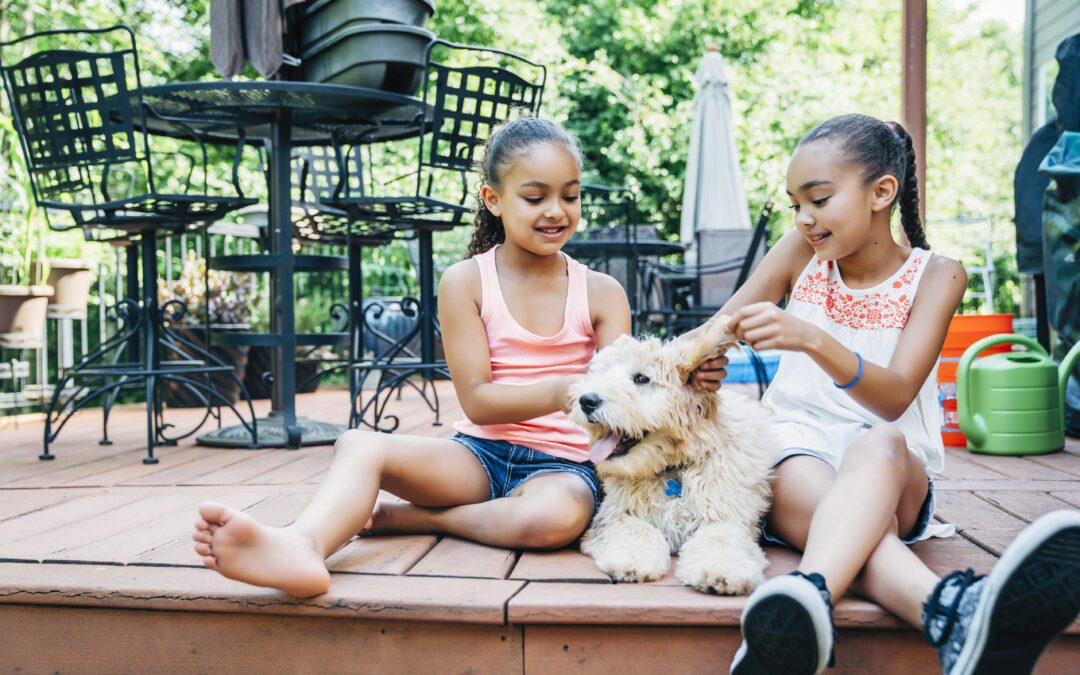A well built deck can be a relaxing retreat, an entertainment hub, or a quiet place to enjoy the outdoors. But if you have young children or pets at home, safety should be at the top of your list. Whether you are planning a new build or improving your existing deck, a few smart design choices and regular checks can make all the difference in keeping everyone safe.
This guide covers practical steps to make your deck a safe and secure space for the smallest members of your family, both two legged and four.
Start with a Strong, Code Compliant Structure
Before anything else, make sure your deck is structurally sound. A safe layout, quality materials, and code compliant construction provide the base for all other safety features.
At All Hands on Deck, we build decks that follow or exceed local building codes in British Columbia. That means correct railing heights, proper stair spacing, strong footings, and secure connections. A deck that is solid and well built is already safer for kids and pets even before any added features.
Choose the Right Railing System
Railings are the most important safety feature on any elevated deck. For families with children and pets, they need to be strong, well spaced, and built with materials that minimize risks.
What to look for
- Vertical balusters spaced close enough to prevent small heads or bodies from slipping through
- Rail height that meets code based on deck height
- Smooth surfaces with no sharp edges or gaps
- Solid fastening to prevent wiggling or movement
For pets, especially small dogs or cats, additional screening or pet barriers can be added inside the railing to block gaps while still maintaining airflow and views.
Add Gates at Stairs
If your deck has stairs, consider installing a gate to keep toddlers or pets from wandering off unsupervised. Gates can be built to match the deck’s material or added as a removable feature.
We often build custom gates for clients who want a seamless look that blends with the rest of the railing. They can be latched and secured easily without being an eyesore or safety hazard.
Use Non Slip Materials
Wet wood, especially when covered in leaves or algae, can become slippery. This is dangerous for both kids running around and pets who may not be able to slow down in time.
Ways to reduce slips
- Choose decking boards with textured or grooved surfaces
- Avoid glossy finishes that become slick when wet
- Use outdoor rugs with rubber backing in play areas or under pet dishes
- Keep the deck clean and clear of debris
Composite decking is a good option for families. It resists moisture, stays more even in texture, and is easier to clean than traditional wood.
Avoid Sharp Edges and Protruding Fasteners
Young children and curious animals often touch, climb, or paw at anything within reach. That means it is important to keep surfaces smooth and hardware covered.
We recommend
- Hidden fasteners or screws driven deep below the surface
- Sanded or rounded edges on benches, rails, and steps
- No exposed nails or hardware where paws or fingers could catch
If your current deck has visible hazards, they can often be corrected with minor upgrades or repairs.
Shade and Shelter Options
Too much sun or sudden rain can cause problems for kids and pets left unattended even for a few minutes. Adding some cover can go a long way.
Consider
- A pergola or canopy to block strong sunlight
- A covered section of the deck for rainy days
- Tall planters or privacy screens for extra shade and wind protection
Covered areas also give pets a place to rest without overheating or getting soaked.
Built In Seating and Boundaries
Loose furniture can be knocked over or climbed on. Built in benches provide safe, stable seating that stays in place and doubles as storage. We often add hidden storage under benches to keep toys or leashes close without cluttering the space.
Low planter boxes or privacy panels can also serve as visual boundaries to keep pets and toddlers from wandering too close to edges or stairs.
Avoid Toxic Plants and Materials
Many common outdoor plants and finishes can be harmful if touched or chewed. If your deck is used often by children or animals, be cautious about what you plant nearby or apply to the surfaces.
Safe practices include
- Using pet friendly sealants and stains
- Avoiding plants like lilies, azaleas, or oleander which are toxic to pets
- Keeping planters at a height that prevents curious snacking
If in doubt, consult a local nursery or veterinarian for plant recommendations that are safe and suitable for decks.
Keep the Deck Clean and Inspected
Even a well built deck needs regular care to stay safe. Small issues can become big hazards if left unchecked.
Make it a habit to
- Sweep and hose off the surface weekly during spring and summer
- Check railings and stairs every few months for looseness or damage
- Watch for signs of rot, especially around posts or shaded areas
- Keep pet waste cleaned up quickly to avoid stains and smells
- Remove sharp debris or toys from walkways and stairs
These simple steps help maintain both the look and safety of your outdoor space.
Add Lighting for Visibility
Good lighting is essential for evening use. It helps prevent trips and makes the space safer for everyone.
Popular lighting choices
- Post cap lights to softly illuminate corners
- Stair lights to make each step visible
- Under rail lights to brighten the edges without harsh glare
- Solar lights for energy efficient, low maintenance use
We can install lighting systems during your build or add them later to improve safety and comfort.
Final Thought
A deck is more than just an outdoor platform. For families with kids or pets, it is part of everyday life. It should feel open, welcoming, and above all, safe. With a few smart design choices and a focus on strong construction, your deck can be a space where everyone enjoys the outdoors with peace of mind.Ready to build a deck your whole family can enjoy safely? Contact All Hands on Deck to plan a custom design that puts safety and comfort first.



Recent Comments